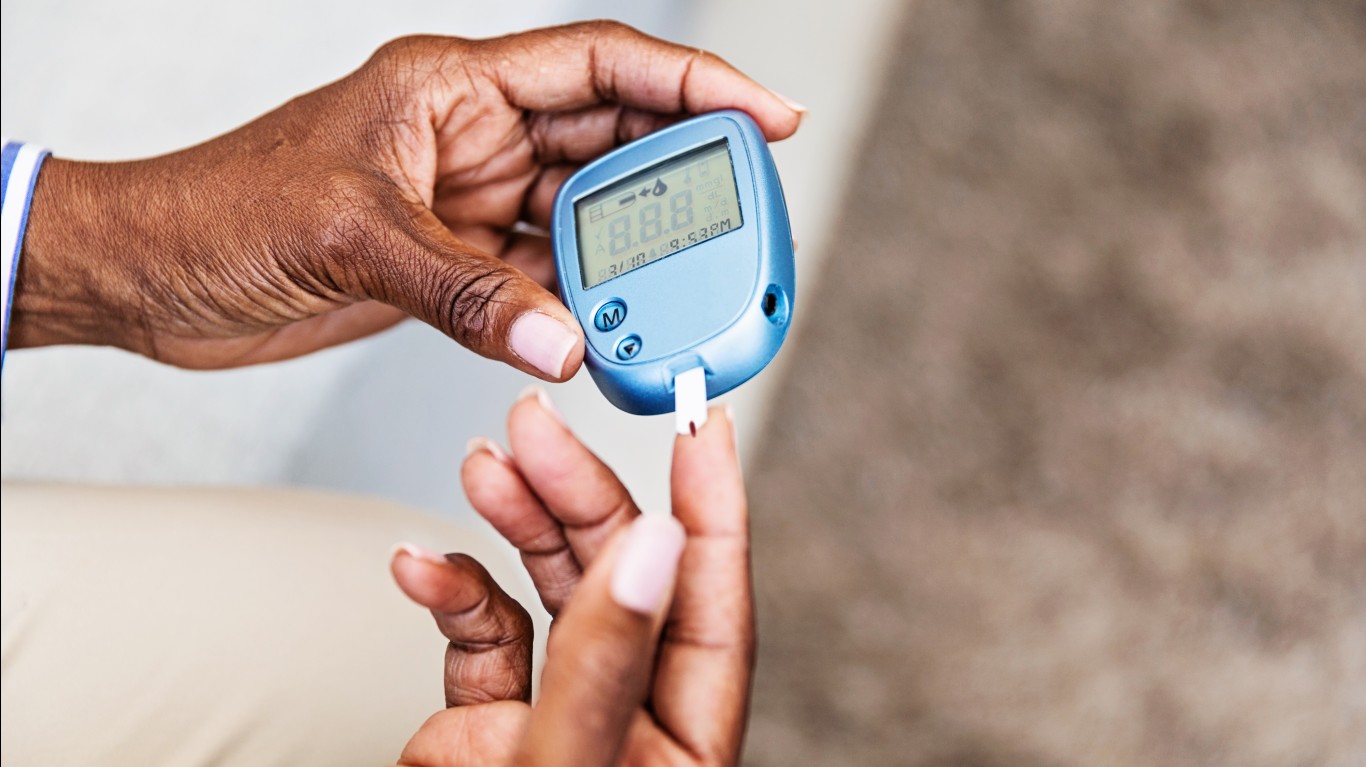
About one in 10 Americans, or 34.2 million people, live with diabetes, according to the Centers for Disease Control and Prevention data through 2018. And one in three people in the country – or 88 million adults — have prediabetes, which is higher than normal blood sugar level that can turn into diabetes if left untreated.
New cases of diabetes have been skyrocketing among young people, and the overall rates of the chronic condition have been on the rise in every state over the last several years.
To determine the states with the highest increase in people with diabetes in a decade, 24/7 Tempo reviewed 2011 and 2021 diabetes data from County Health Rankings & Roadmaps, a Robert Wood Johnson Foundation and University of Wisconsin Population Health Institute joint program. The data released in the 2011 and 2021 reports are for years 2008 and 2017, respectively.
There are three types of diabetes: Type 1, Type 2, and gestational. People with Type 1 diabetes, comprising about 5%-10% of diabetes cases, make very little or no insulin — a hormone made by the pancreas that helps regulate blood sugar levels in the body by allowing cells to store the broken down sugars, or glucose (the body’s energy source). Those with Type 1 diabetes must take insulin every day.
People with Type 2 diabetes may produce insulin, but they don’t use it well. Their body is not capable of regulating blood sugar levels. The third type, gestational diabetes, develops in pregnant women. Blood sugar levels usually return to normal after childbirth.
Several factors may increase the risk of Type 2 diabetes. The ones that cannot be controlled are age and family history. Those that can be controlled include a sedentary lifestyle and a healthy diet. Obesity is a leading risk factor for Type 2 diabetes.
Obesity and severe obesity trends have generally increased over the past decade. In fact, the share of adults who are obese has increased in every state between 2008 and 2017, though the range of increase is significant — from 5.9% in Michigan to 22.1% in Iowa.
Increased use of foods high in sugar, fried foods, and processed foods has contributed to unhealthy eating patterns among Americans. These foods can induce chronic inflammation, which can lead to diabetes.
Some diseases, including diabetes, have a particular odor and vague symptoms that seem completely normal daily activities — like drinking coffee and eating cookies. Here are 18 ordinary habits that can be signs of serious health problems.
Click here to see states with the largest increase in diabetes in a decade.
Click here to see our detailed methodology.

50. Massachusetts
> Increase in adults 20+ with diabetes, 2008-2017: 0.3 percentage points
> Pct. of adults 20+ with diabetes in 2008: 8.4% — 20th highest
> Pct. of adults 20+ with diabetes in 2017: 8.7% — 5th lowest
> Change in adult obesity: From 22.9% in 2008 to 25.0% in 2017
> Change in adults who don’t exercise: From 22.2% in 2008 to 20.0% in 2017
> Change in limited access to healthy foods: From 7.0% in 2009 to 4.1% in 2017
> Change in median household income: From $65,401 in 2008 to $85,843 in 2019
[in-text-ad]

49. Utah
> Increase in adults 20+ with diabetes, 2008-2017: 0.9 percentage points
> Pct. of adults 20+ with diabetes in 2008: 6.6% — 7th lowest
> Pct. of adults 20+ with diabetes in 2017: 7.5% — 2nd lowest
> Change in adult obesity: From 24.2% in 2008 to 27.0% in 2017
> Change in adults who don’t exercise: From 18.5% in 2008 to 16.7% in 2017
> Change in limited access to healthy foods: From 7.3% in 2009 to 5.8% in 2017
> Change in median household income: From $56,633 in 2008 to $75,780 in 2019

48. Idaho
> Increase in adults 20+ with diabetes, 2008-2017: 1.0 percentage points
> Pct. of adults 20+ with diabetes in 2008: 8.3% — 21st highest
> Pct. of adults 20+ with diabetes in 2017: 9.3% — 12th lowest
> Change in adult obesity: From 25.6% in 2008 to 29.0% in 2017
> Change in adults who don’t exercise: From 20.0% in 2008 to 20.4% in 2017
> Change in limited access to healthy foods: From 4.3% in 2009 to 7.1% in 2017
> Change in median household income: From $47,576 in 2008 to $60,999 in 2019

47. New Jersey
> Increase in adults 20+ with diabetes, 2008-2017: 1.0 percentage points
> Pct. of adults 20+ with diabetes in 2008: 8.9% — 17th highest
> Pct. of adults 20+ with diabetes in 2017: 9.9% — 21st lowest
> Change in adult obesity: From 24.0% in 2008 to 27.0% in 2017
> Change in adults who don’t exercise: From 25.3% in 2008 to 26.6% in 2017
> Change in limited access to healthy foods: From 6.6% in 2009 to 3.6% in 2017
> Change in median household income: From $70,378 in 2008 to $85,751 in 2019

46. Florida
> Increase in adults 20+ with diabetes, 2008-2017: 1.3 percentage points
> Pct. of adults 20+ with diabetes in 2008: 9.5% — 12th highest
> Pct. of adults 20+ with diabetes in 2017: 10.8% — 20th highest
> Change in adult obesity: From 24.4% in 2008 to 27.2% in 2017
> Change in adults who don’t exercise: From 24.1% in 2008 to 25.8% in 2017
> Change in limited access to healthy foods: From 4.0% in 2009 to 7.2% in 2017
> Change in median household income: From $47,778 in 2008 to $59,227 in 2019

45. Maryland
> Increase in adults 20+ with diabetes, 2008-2017: 1.3 percentage points
> Pct. of adults 20+ with diabetes in 2008: 9.8% — 9th highest
> Pct. of adults 20+ with diabetes in 2017: 11.1% — 16th highest
> Change in adult obesity: From 27.3% in 2008 to 31.6% in 2017
> Change in adults who don’t exercise: From 23.9% in 2008 to 21.9% in 2017
> Change in limited access to healthy foods: From 7.0% in 2009 to 3.4% in 2017
> Change in median household income: From $70,545 in 2008 to $86,738 in 2019
[in-text-ad]

44. Connecticut
> Increase in adults 20+ with diabetes, 2008-2017: 1.5 percentage points
> Pct. of adults 20+ with diabetes in 2008: 7.7% — 19th lowest
> Pct. of adults 20+ with diabetes in 2017: 9.2% — 10th lowest
> Change in adult obesity: From 22.3% in 2008 to 26.3% in 2017
> Change in adults who don’t exercise: From 21.8% in 2008 to 19.9% in 2017
> Change in limited access to healthy foods: From 7.3% in 2009 to 4.3% in 2017
> Change in median household income: From $68,595 in 2008 to $78,833 in 2019

43. California
> Increase in adults 20+ with diabetes, 2008-2017: 1.6 percentage points
> Pct. of adults 20+ with diabetes in 2008: 7.2% — 13th lowest
> Pct. of adults 20+ with diabetes in 2017: 8.8% — 7th lowest
> Change in adult obesity: From 22.8% in 2008 to 24.3% in 2017
> Change in adults who don’t exercise: From 18.6% in 2008 to 17.7% in 2017
> Change in limited access to healthy foods: From 0.0% in 2009 to 3.3% in 2017
> Change in median household income: From $61,021 in 2008 to $80,440 in 2019
[in-text-ad-2]

42. New Hampshire
> Increase in adults 20+ with diabetes, 2008-2017: 1.6 percentage points
> Pct. of adults 20+ with diabetes in 2008: 8.0% — 25th highest
> Pct. of adults 20+ with diabetes in 2017: 9.6% — 17th lowest
> Change in adult obesity: From 25.7% in 2008 to 28.6% in 2017
> Change in adults who don’t exercise: From 21.4% in 2008 to 20.8% in 2017
> Change in limited access to healthy foods: From 9.4% in 2009 to 5.0% in 2017
> Change in median household income: From $63,731 in 2008 to $77,933 in 2019

41. Maine
> Increase in adults 20+ with diabetes, 2008-2017: 1.6 percentage points
> Pct. of adults 20+ with diabetes in 2008: 8.8% — 18th highest
> Pct. of adults 20+ with diabetes in 2017: 10.4% — 24th highest
> Change in adult obesity: From 26.0% in 2008 to 29.8% in 2017
> Change in adults who don’t exercise: From 21.9% in 2008 to 20.8% in 2017
> Change in limited access to healthy foods: From 14.8% in 2009 to 3.8% in 2017
> Change in median household income: From $46,581 in 2008 to $58,924 in 2019

40. Tennessee
> Increase in adults 20+ with diabetes, 2008-2017: 1.6 percentage points
> Pct. of adults 20+ with diabetes in 2008: 10.9% — 6th highest
> Pct. of adults 20+ with diabetes in 2017: 12.5% — 8th highest
> Change in adult obesity: From 31.2% in 2008 to 33.3% in 2017
> Change in adults who don’t exercise: From 30.7% in 2008 to 27.2% in 2017
> Change in limited access to healthy foods: From 12.2% in 2009 to 8.5% in 2017
> Change in median household income: From $43,614 in 2008 to $56,071 in 2019
[in-text-ad-2]

39. Louisiana
> Increase in adults 20+ with diabetes, 2008-2017: 1.6 percentage points
> Pct. of adults 20+ with diabetes in 2008: 11.4% — 4th highest
> Pct. of adults 20+ with diabetes in 2017: 13.0% — 6th highest
> Change in adult obesity: From 31.5% in 2008 to 36.3% in 2017
> Change in adults who don’t exercise: From 29.9% in 2008 to 28.0% in 2017
> Change in limited access to healthy foods: From 9.6% in 2009 to 9.5% in 2017
> Change in median household income: From $43,733 in 2008 to $51,073 in 2019

38. Mississippi
> Increase in adults 20+ with diabetes, 2008-2017: 1.7 percentage points
> Pct. of adults 20+ with diabetes in 2008: 12.9% — the highest
> Pct. of adults 20+ with diabetes in 2017: 14.6% — 2nd highest
> Change in adult obesity: From 34.3% in 2008 to 39.1% in 2017
> Change in adults who don’t exercise: From 32.4% in 2008 to 30.4% in 2017
> Change in limited access to healthy foods: From 7.4% in 2009 to 10.7% in 2017
> Change in median household income: From $37,790 in 2008 to $45,792 in 2019

37. Montana
> Increase in adults 20+ with diabetes, 2008-2017: 1.7 percentage points
> Pct. of adults 20+ with diabetes in 2008: 7.2% — 13th lowest
> Pct. of adults 20+ with diabetes in 2017: 8.9% — 8th lowest
> Change in adult obesity: From 23.3% in 2008 to 27.1% in 2017
> Change in adults who don’t exercise: From 21.3% in 2008 to 21.7% in 2017
> Change in limited access to healthy foods: From 6.7% in 2009 to 8.3% in 2017
> Change in median household income: From $43,654 in 2008 to $57,153 in 2019

36. Colorado
> Increase in adults 20+ with diabetes, 2008-2017: 1.8 percentage points
> Pct. of adults 20+ with diabetes in 2008: 4.8% — the lowest
> Pct. of adults 20+ with diabetes in 2017: 6.6% — the lowest
> Change in adult obesity: From 18.7% in 2008 to 22.4% in 2017
> Change in adults who don’t exercise: From 15.7% in 2008 to 14.8% in 2017
> Change in limited access to healthy foods: From 7.2% in 2009 to 5.5% in 2017
> Change in median household income: From $56,993 in 2008 to $77,127 in 2019
[in-text-ad]

35. Wyoming
> Increase in adults 20+ with diabetes, 2008-2017: 1.8 percentage points
> Pct. of adults 20+ with diabetes in 2008: 7.2% — 13th lowest
> Pct. of adults 20+ with diabetes in 2017: 9.0% — 9th lowest
> Change in adult obesity: From 25.0% in 2008 to 29.2% in 2017
> Change in adults who don’t exercise: From 22.9% in 2008 to 23.1% in 2017
> Change in limited access to healthy foods: From 13.5% in 2009 to 8.7% in 2017
> Change in median household income: From $53,207 in 2008 to $65,003 in 2019

34. Washington
> Increase in adults 20+ with diabetes, 2008-2017: 1.8 percentage points
> Pct. of adults 20+ with diabetes in 2008: 7.5% — 16th lowest
> Pct. of adults 20+ with diabetes in 2017: 9.3% — 12th lowest
> Change in adult obesity: From 26.6% in 2008 to 28.6% in 2017
> Change in adults who don’t exercise: From 18.2% in 2008 to 16.4% in 2017
> Change in limited access to healthy foods: From 4.6% in 2009 to 5.5% in 2017
> Change in median household income: From $58,078 in 2008 to $78,687 in 2019

33. North Dakota
> Increase in adults 20+ with diabetes, 2008-2017: 1.8 percentage points
> Pct. of adults 20+ with diabetes in 2008: 7.6% — 18th lowest
> Pct. of adults 20+ with diabetes in 2017: 9.4% — 13th lowest
> Change in adult obesity: From 28.2% in 2008 to 33.9% in 2017
> Change in adults who don’t exercise: From 25.2% in 2008 to 23.1% in 2017
> Change in limited access to healthy foods: From 5.7% in 2009 to 7.0% in 2017
> Change in median household income: From $45,685 in 2008 to $64,577 in 2019
[in-text-ad]

32. Arizona
> Increase in adults 20+ with diabetes, 2008-2017: 1.8 percentage points
> Pct. of adults 20+ with diabetes in 2008: 7.8% — 21st lowest
> Pct. of adults 20+ with diabetes in 2017: 9.6% — 17th lowest
> Change in adult obesity: From 23.8% in 2008 to 27.9% in 2017
> Change in adults who don’t exercise: From 20.3% in 2008 to 21.2% in 2017
> Change in limited access to healthy foods: From 11.2% in 2009 to 7.5% in 2017
> Change in median household income: From $50,958 in 2008 to $62,055 in 2019
[in-text-ad]

31. Oregon
> Increase in adults 20+ with diabetes, 2008-2017: 1.8 percentage points
> Pct. of adults 20+ with diabetes in 2008: 7.9% — 23rd lowest
> Pct. of adults 20+ with diabetes in 2017: 9.7% — 18th lowest
> Change in adult obesity: From 25.1% in 2008 to 29.3% in 2017
> Change in adults who don’t exercise: From 17.4% in 2008 to 17.3% in 2017
> Change in limited access to healthy foods: From 6.6% in 2009 to 5.4% in 2017
> Change in median household income: From $50,169 in 2008 to $67,058 in 2019

30. Michigan
> Increase in adults 20+ with diabetes, 2008-2017: 1.8 percentage points
> Pct. of adults 20+ with diabetes in 2008: 9.2% — 15th highest
> Pct. of adults 20+ with diabetes in 2017: 11.0% — 18th highest
> Change in adult obesity: From 30.6% in 2008 to 32.4% in 2017
> Change in adults who don’t exercise: From 24.2% in 2008 to 23.1% in 2017
> Change in limited access to healthy foods: From 13.7% in 2009 to 6.3% in 2017
> Change in median household income: From $48,591 in 2008 to $59,584 in 2019
[in-text-ad-2]

29. Vermont
> Increase in adults 20+ with diabetes, 2008-2017: 1.9 percentage points
> Pct. of adults 20+ with diabetes in 2008: 6.9% — 9th lowest
> Pct. of adults 20+ with diabetes in 2017: 8.8% — 7th lowest
> Change in adult obesity: From 22.9% in 2008 to 27.0% in 2017
> Change in adults who don’t exercise: From 19.2% in 2008 to 18.4% in 2017
> Change in limited access to healthy foods: From 11.6% in 2009 to 3.3% in 2017
> Change in median household income: From $52,104 in 2008 to $63,001 in 2019

28. Alaska
> Increase in adults 20+ with diabetes, 2008-2017: 1.9 percentage points
> Pct. of adults 20+ with diabetes in 2008: 6.4% — 3rd lowest
> Pct. of adults 20+ with diabetes in 2017: 8.3% — 3rd lowest
> Change in adult obesity: From 27.9% in 2008 to 31.9% in 2017
> Change in adults who don’t exercise: From 22.6% in 2008 to 19.3% in 2017
> Change in limited access to healthy foods: From 4.4% in 2009 to 9.2% in 2017
> Change in median household income: From $68,460 in 2008 to $75,463 in 2019
[in-text-ad]

27. North Carolina
> Increase in adults 20+ with diabetes, 2008-2017: 2.0 percentage points
> Pct. of adults 20+ with diabetes in 2008: 9.5% — 12th highest
> Pct. of adults 20+ with diabetes in 2017: 11.5% — 14th highest
> Change in adult obesity: From 28.7% in 2008 to 32.3% in 2017
> Change in adults who don’t exercise: From 24.0% in 2008 to 23.3% in 2017
> Change in limited access to healthy foods: From 6.8% in 2009 to 6.7% in 2017
> Change in median household income: From $46,549 in 2008 to $57,341 in 2019

26. South Carolina
> Increase in adults 20+ with diabetes, 2008-2017: 2.0 percentage points
> Pct. of adults 20+ with diabetes in 2008: 11.3% — 5th highest
> Pct. of adults 20+ with diabetes in 2017: 13.3% — 5th highest
> Change in adult obesity: From 30.0% in 2008 to 34.0% in 2017
> Change in adults who don’t exercise: From 27.0% in 2008 to 26.0% in 2017
> Change in limited access to healthy foods: From 6.4% in 2009 to 9.1% in 2017
> Change in median household income: From $44,625 in 2008 to $56,227 in 2019

25. Wisconsin
> Increase in adults 20+ with diabetes, 2008-2017: 2.1 percentage points
> Pct. of adults 20+ with diabetes in 2008: 7.4% — 15th lowest
> Pct. of adults 20+ with diabetes in 2017: 9.5% — 15th lowest
> Change in adult obesity: From 28.2% in 2008 to 31.7% in 2017
> Change in adults who don’t exercise: From 22.7% in 2008 to 20.3% in 2017
> Change in limited access to healthy foods: From 6.3% in 2009 to 4.8% in 2017
> Change in median household income: From $52,094 in 2008 to $64,168 in 2019
[in-text-ad-2]

24. Rhode Island
> Increase in adults 20+ with diabetes, 2008-2017: 2.1 percentage points
> Pct. of adults 20+ with diabetes in 2008: 8.0% — 25th highest
> Pct. of adults 20+ with diabetes in 2017: 10.1% — 25th lowest
> Change in adult obesity: From 24.0% in 2008 to 28.5% in 2017
> Change in adults who don’t exercise: From 24.6% in 2008 to 23.5% in 2017
> Change in limited access to healthy foods: From 4.8% in 2009 to 4.7% in 2017
> Change in median household income: From $55,701 in 2008 to $71,169 in 2019

23. Kentucky
> Increase in adults 20+ with diabetes, 2008-2017: 2.1 percentage points
> Pct. of adults 20+ with diabetes in 2008: 10.6% — 7th highest
> Pct. of adults 20+ with diabetes in 2017: 12.7% — 7th highest
> Change in adult obesity: From 31.2% in 2008 to 34.6% in 2017
> Change in adults who don’t exercise: From 31.9% in 2008 to 28.7% in 2017
> Change in limited access to healthy foods: From 0.0% in 2009 to 5.6% in 2017
> Change in median household income: From $41,538 in 2008 to $52,295 in 2019

22. New York
> Increase in adults 20+ with diabetes, 2008-2017: 2.2 percentage points
> Pct. of adults 20+ with diabetes in 2008: 7.9% — 23rd lowest
> Pct. of adults 20+ with diabetes in 2017: 10.1% — 25th lowest
> Change in adult obesity: From 24.5% in 2008 to 26.4% in 2017
> Change in adults who don’t exercise: From 25.2% in 2008 to 23.4% in 2017
> Change in limited access to healthy foods: From 5.8% in 2009 to 2.3% in 2017
> Change in median household income: From $56,033 in 2008 to $72,108 in 2019

21. Nevada
> Increase in adults 20+ with diabetes, 2008-2017: 2.4 percentage points
> Pct. of adults 20+ with diabetes in 2008: 8.1% — 24th highest
> Pct. of adults 20+ with diabetes in 2017: 10.5% — 22nd highest
> Change in adult obesity: From 25.4% in 2008 to 27.1% in 2017
> Change in adults who don’t exercise: From 23.5% in 2008 to 22.5% in 2017
> Change in limited access to healthy foods: From 8.8% in 2009 to 5.4% in 2017
> Change in median household income: From $56,361 in 2008 to $63,276 in 2019
[in-text-ad]

20. Ohio
> Increase in adults 20+ with diabetes, 2008-2017: 2.4 percentage points
> Pct. of adults 20+ with diabetes in 2008: 9.8% — 9th highest
> Pct. of adults 20+ with diabetes in 2017: 12.2% — 10th highest
> Change in adult obesity: From 29.5% in 2008 to 33.5% in 2017
> Change in adults who don’t exercise: From 26.2% in 2008 to 26.1% in 2017
> Change in limited access to healthy foods: From 11.1% in 2009 to 6.8% in 2017
> Change in median household income: From $47,988 in 2008 to $58,642 in 2019

19. Pennsylvania
> Increase in adults 20+ with diabetes, 2008-2017: 2.4 percentage points
> Pct. of adults 20+ with diabetes in 2008: 8.6% — 19th highest
> Pct. of adults 20+ with diabetes in 2017: 11.0% — 18th highest
> Change in adult obesity: From 28.1% in 2008 to 30.8% in 2017
> Change in adults who don’t exercise: From 25.6% in 2008 to 22.0% in 2017
> Change in limited access to healthy foods: From 8.6% in 2009 to 4.6% in 2017
> Change in median household income: From $50,713 in 2008 to $63,463 in 2019

18. Delaware
> Increase in adults 20+ with diabetes, 2008-2017: 2.6 percentage points
> Pct. of adults 20+ with diabetes in 2008: 9.2% — 15th highest
> Pct. of adults 20+ with diabetes in 2017: 11.8% — 13th highest
> Change in adult obesity: From 28.5% in 2008 to 32.4% in 2017
> Change in adults who don’t exercise: From 23.6% in 2008 to 27.3% in 2017
> Change in limited access to healthy foods: From 7.8% in 2009 to 4.7% in 2017
> Change in median household income: From $57,989 in 2008 to $70,176 in 2019

17. Indiana
> Increase in adults 20+ with diabetes, 2008-2017: 2.6 percentage points
> Pct. of adults 20+ with diabetes in 2008: 9.5% — 12th highest
> Pct. of adults 20+ with diabetes in 2017: 12.1% — 11th highest
> Change in adult obesity: From 29.7% in 2008 to 33.9% in 2017
> Change in adults who don’t exercise: From 27.3% in 2008 to 26.7% in 2017
> Change in limited access to healthy foods: From 3.9% in 2009 to 6.9% in 2017
> Change in median household income: From $47,966 in 2008 to $57,603 in 2019
[in-text-ad-2]

16. Alabama
> Increase in adults 20+ with diabetes, 2008-2017: 2.6 percentage points
> Pct. of adults 20+ with diabetes in 2008: 11.9% — 3rd highest
> Pct. of adults 20+ with diabetes in 2017: 14.5% — 3rd highest
> Change in adult obesity: From 31.9% in 2008 to 36.1% in 2017
> Change in adults who don’t exercise: From 30.5% in 2008 to 29.3% in 2017
> Change in limited access to healthy foods: From 8.7% in 2009 to 7.9% in 2017
> Change in median household income: From $42,666 in 2008 to $51,734 in 2019

15. Oklahoma
> Increase in adults 20+ with diabetes, 2008-2017: 2.7 percentage points
> Pct. of adults 20+ with diabetes in 2008: 9.6% — 11th highest
> Pct. of adults 20+ with diabetes in 2017: 12.3% — 9th highest
> Change in adult obesity: From 30.2% in 2008 to 34.5% in 2017
> Change in adults who don’t exercise: From 31.2% in 2008 to 27.8% in 2017
> Change in limited access to healthy foods: From 4.9% in 2009 to 8.6% in 2017
> Change in median household income: From $42,822 in 2008 to $54,449 in 2019

14. South Dakota
> Increase in adults 20+ with diabetes, 2008-2017: 2.7 percentage points
> Pct. of adults 20+ with diabetes in 2008: 7.4% — 15th lowest
> Pct. of adults 20+ with diabetes in 2017: 10.1% — 25th lowest
> Change in adult obesity: From 28.6% in 2008 to 32.4% in 2017
> Change in adults who don’t exercise: From 25.6% in 2008 to 22.0% in 2017
> Change in limited access to healthy foods: From 5.4% in 2009 to 10.5% in 2017
> Change in median household income: From $46,032 in 2008 to $59,533 in 2019
[in-text-ad]

13. West Virginia
> Increase in adults 20+ with diabetes, 2008-2017: 2.8 percentage points
> Pct. of adults 20+ with diabetes in 2008: 12.3% — 2nd highest
> Pct. of adults 20+ with diabetes in 2017: 15.1% — the highest
> Change in adult obesity: From 31.5% in 2008 to 37.8% in 2017
> Change in adults who don’t exercise: From 31.3% in 2008 to 28.0% in 2017
> Change in limited access to healthy foods: From 12.3% in 2009 to 6.6% in 2017
> Change in median household income: From $37,989 in 2008 to $48,850 in 2019

12. Minnesota
> Increase in adults 20+ with diabetes, 2008-2017: 2.8 percentage points
> Pct. of adults 20+ with diabetes in 2008: 5.7% — 2nd lowest
> Pct. of adults 20+ with diabetes in 2017: 8.5% — 4th lowest
> Change in adult obesity: From 26.2% in 2008 to 29.0% in 2017
> Change in adults who don’t exercise: From 16.7% in 2008 to 19.6% in 2017
> Change in limited access to healthy foods: From 10.3% in 2009 to 5.6% in 2017
> Change in median household income: From $57,288 in 2008 to $74,593 in 2019
[in-text-ad-2]

11. Illinois
> Increase in adults 20+ with diabetes, 2008-2017: 2.8 percentage points
> Pct. of adults 20+ with diabetes in 2008: 7.1% — 10th lowest
> Pct. of adults 20+ with diabetes in 2017: 9.9% — 21st lowest
> Change in adult obesity: From 26.3% in 2008 to 29.7% in 2017
> Change in adults who don’t exercise: From 22.8% in 2008 to 21.6% in 2017
> Change in limited access to healthy foods: From 14.5% in 2009 to 4.5% in 2017
> Change in median household income: From $56,235 in 2008 to $69,187 in 2019

10. New Mexico
> Increase in adults 20+ with diabetes, 2008-2017: 2.9 percentage points
> Pct. of adults 20+ with diabetes in 2008: 6.6% — 7th lowest
> Pct. of adults 20+ with diabetes in 2017: 9.5% — 15th lowest
> Change in adult obesity: From 22.9% in 2008 to 27.3% in 2017
> Change in adults who don’t exercise: From 19.7% in 2008 to 19.0% in 2017
> Change in limited access to healthy foods: From 7.0% in 2009 to 14.0% in 2017
> Change in median household income: From $43,508 in 2008 to $51,945 in 2019
[in-text-ad-2]

9. Kansas
> Increase in adults 20+ with diabetes, 2008-2017: 2.9 percentage points
> Pct. of adults 20+ with diabetes in 2008: 7.6% — 18th lowest
> Pct. of adults 20+ with diabetes in 2017: 10.5% — 22nd highest
> Change in adult obesity: From 29.0% in 2008 to 33.0% in 2017
> Change in adults who don’t exercise: From 23.6% in 2008 to 23.9% in 2017
> Change in limited access to healthy foods: From 10.3% in 2009 to 8.3% in 2017
> Change in median household income: From $50,177 in 2008 to $62,087 in 2019

8. Virginia
> Increase in adults 20+ with diabetes, 2008-2017: 2.9 percentage points
> Pct. of adults 20+ with diabetes in 2008: 7.8% — 21st lowest
> Pct. of adults 20+ with diabetes in 2017: 10.7% — 21st highest
> Change in adult obesity: From 26.9% in 2008 to 30.5% in 2017
> Change in adults who don’t exercise: From 22.8% in 2008 to 22.2% in 2017
> Change in limited access to healthy foods: From 6.3% in 2009 to 4.3% in 2017
> Change in median household income: From $61,233 in 2008 to $76,456 in 2019

7. Hawaii
> Increase in adults 20+ with diabetes, 2008-2017: 2.9 percentage points
> Pct. of adults 20+ with diabetes in 2008: 8.2% — 23rd highest
> Pct. of adults 20+ with diabetes in 2017: 11.1% — 16th highest
> Change in adult obesity: From 21.2% in 2008 to 24.6% in 2017
> Change in adults who don’t exercise: From 17.9% in 2008 to 19.6% in 2017
> Change in limited access to healthy foods: From 10.8% in 2009 to 6.9% in 2017
> Change in median household income: From $67,214 in 2008 to $83,102 in 2019
[in-text-ad]

6. Nebraska
> Increase in adults 20+ with diabetes, 2008-2017: 3.1 percentage points
> Pct. of adults 20+ with diabetes in 2008: 6.9% — 9th lowest
> Pct. of adults 20+ with diabetes in 2017: 10.0% — 22nd lowest
> Change in adult obesity: From 28.5% in 2008 to 33.4% in 2017
> Change in adults who don’t exercise: From 24.2% in 2008 to 22.7% in 2017
> Change in limited access to healthy foods: From 13.9% in 2009 to 5.6% in 2017
> Change in median household income: From $49,693 in 2008 to $63,229 in 2019

5. Iowa
> Increase in adults 20+ with diabetes, 2008-2017: 3.4 percentage points
> Pct. of adults 20+ with diabetes in 2008: 6.5% — 5th lowest
> Pct. of adults 20+ with diabetes in 2017: 9.9% — 21st lowest
> Change in adult obesity: From 28.1% in 2008 to 34.3% in 2017
> Change in adults who don’t exercise: From 25.1% in 2008 to 22.6% in 2017
> Change in limited access to healthy foods: From 6.3% in 2009 to 5.6% in 2017
> Change in median household income: From $48,980 in 2008 to $61,691 in 2019

4. Missouri
> Increase in adults 20+ with diabetes, 2008-2017: 3.4 percentage points
> Pct. of adults 20+ with diabetes in 2008: 8.0% — 25th highest
> Pct. of adults 20+ with diabetes in 2017: 11.4% — 15th highest
> Change in adult obesity: From 30.1% in 2008 to 32.5% in 2017
> Change in adults who don’t exercise: From 27.1% in 2008 to 25.5% in 2017
> Change in limited access to healthy foods: From 4.5% in 2009 to 6.8% in 2017
> Change in median household income: From $46,867 in 2008 to $57,409 in 2019

3. Arkansas
> Increase in adults 20+ with diabetes, 2008-2017: 3.5 percentage points
> Pct. of adults 20+ with diabetes in 2008: 10.0% — 8th highest
> Pct. of adults 20+ with diabetes in 2017: 13.5% — 4th highest
> Change in adult obesity: From 30.3% in 2008 to 35.0% in 2017
> Change in adults who don’t exercise: From 29.8% in 2008 to 30.4% in 2017
> Change in limited access to healthy foods: From 10.9% in 2009 to 8.7% in 2017
> Change in median household income: From $38,815 in 2008 to $48,952 in 2019
[in-text-ad-2]

2. Texas
> Increase in adults 20+ with diabetes, 2008-2017: 3.7 percentage points
> Pct. of adults 20+ with diabetes in 2008: 6.5% — 5th lowest
> Pct. of adults 20+ with diabetes in 2017: 10.2% — 25th highest
> Change in adult obesity: From 27.0% in 2008 to 31.4% in 2017
> Change in adults who don’t exercise: From 22.3% in 2008 to 23.2% in 2017
> Change in limited access to healthy foods: From 6.4% in 2009 to 8.7% in 2017
> Change in median household income: From $50,043 in 2008 to $64,034 in 2019

1. Georgia
> Increase in adults 20+ with diabetes, 2008-2017: 3.7 percentage points
> Pct. of adults 20+ with diabetes in 2008: 8.3% — 21st highest
> Pct. of adults 20+ with diabetes in 2017: 12.0% — 12th highest
> Change in adult obesity: From 28.1% in 2008 to 32.3% in 2017
> Change in adults who don’t exercise: From 23.6% in 2008 to 26.4% in 2017
> Change in limited access to healthy foods: From 3.7% in 2009 to 9.0% in 2017
> Change in median household income: From $50,861 in 2008 to $61,980 in 2019
Methodology
To determine the states with the highest increase in people with diabetes in a decade, 24/7 Tempo reviewed 2011 and 2021 diabetes data from County Health Rankings & Roadmaps, a Robert Wood Johnson Foundation and University of Wisconsin Population Health Institute joint program. The data released in the 2011 and 2021 reports are for years 2008 and 2017, respectively.
The obesity rates — the share of adult residents who report a body mass index of 30 or greater — came from the 2011 and 2021 CHR reports.
We also considered measures of health factors that may contribute to developing diabetes and how they have changed over the same period of time. Health factors reviewed included measures of healthy behavior such as exercise, limited access to healthy foods, and socioeconomic factors such as annual household income. Limited access to healthy foods measures the percentage of the population that is low income and does not live close to a grocery store.
Physical activity data was compared from the 2011 and 2021 CHR reports.
Data on the shares of adults with limited access to healthy foods in 2012 and in 2021 also came from the CHR. Data was not available in the 2011 report.
Population figures as well as median household income came from the U.S. Census American Community Survey 2011 and 2019 1-Year Estimates.
Travel Cards Are Getting Too Good To Ignore (sponsored)
Credit card companies are pulling out all the stops, with the issuers are offering insane travel rewards and perks.
We’re talking huge sign-up bonuses, points on every purchase, and benefits like lounge access, travel credits, and free hotel nights. For travelers, these rewards can add up to thousands of dollars in flights, upgrades, and luxury experiences every year.
It’s like getting paid to travel — and it’s available to qualified borrowers who know where to look.
We’ve rounded up some of the best travel credit cards on the market. Click here to see the list. Don’t miss these offers — they won’t be this good forever.
Thank you for reading! Have some feedback for us?
Contact the 24/7 Wall St. editorial team.
 24/7 Wall St.
24/7 Wall St. 24/7 Wall St.
24/7 Wall St. 24/7 Wall St.
24/7 Wall St. 24/7 Wall St.
24/7 Wall St. 24/7 Wall St.
24/7 Wall St.


